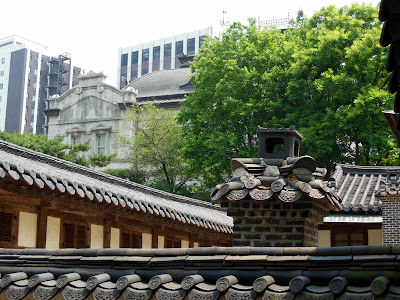Although we are living just seven minute walk away from FM's worksite on the main thoroughfare in downtown Seoul, a two minute jaunt out our back door delivers you directly into the heart of Insadong.
Formerly, Insadong was one of the richest areas of Seoul, home to most government officials and other such muckety mucks. During the Japanese occupation, most wealthy Koreans were forced to sell of their property, which led to the area earning the title of Antique Street.
After the occupation, many antique dealers remained and were joined by artists, rejuvenating the "dong" into one of the most vibrant and Korean custom oriented areas of Seoul. Full of cafes, tea houses, souvenir stands, boutiques, art galleries and restaurants, locals and tourists alike flock to this well-preserved area.
Including us.
 |
| Leaving out our back door and crossing the alley delivers you into a small, mazelike garden owned and maintained by the Jogyesa Buddhist Monastery. |
 |
| However, before you reach the Temple, you will encounter the VERY first Seoul post office. Who's architecture really doesn't vary much from the temples, palaces, etc we keep stumbling over. . . First established in 1884. |
 |
| And where you can currently buy these. . . stop the madness. |
 |
| Main Jogyesa Temple |
 |
| If heading into Insadong from Anguk Station, you will be greeted by these "resident alien" looking guys |
 |
| And from Gyeongbokgung by this large sculpture of a caligraphy brush. |
 |
| Insadong used to be two towns, In and Sa, divided by a stream. Now this fountain stands as a reminder and a small (see left part of photo) rill runs down the main street. |
 |
| I headed over to the Unhyeongung Palace, a smaller Royal dwelling on the eastern border of the district. I liked the three distinct architectural designs visible here. |
 |
| UnHyeongung Palace |
 |
| Unlike a lot of the palaces, this had some of the rooms set up to show what they would have traditionally looked like and were used for. Although a "little" cheesy, it did make the palace come more alive for me than many of the others I've seen. This is depicting a traditional tea ceremony. |
 |
| And this is a traditional kitchen set up. |
 |
| It was a very cute little palace (smaller now than in the past) in a very tranquil setting with a seventy cent admission charge. |
 |
| Cutting back to the west, I zigged and zagged through some old traditional alleys. People are still living in here. As I passed I could hear typical living sounds emanating off the stone walls. This is the zig. . . |
 |
| And then the zag |
 |
Almost immediately I'm back on the main road and eager to check out
a building I just recently read about, the Ssamzigiel, inside this doorway. |
 |
| Although very picturesque and full of psuedo-artworks, it was basically a mall. Now, if there was a beer garden up here on the roof, we'd be TALKING! |
 |
| There were however, sheep made of metal on the roof. |
 |
| Art and grafitti in the stairwells |
 |
| Looking down on the street. The tallest building on the right is our house! |
 |
| Looking north from the roof. |
 |
| More looking from the roof. |
Insadong has a lot more to offer than just this quick glimpse. It was our last stop home on Sunday after going to the Seoul Tower and then booze-cruising home. We enjoyed a nice snack and some ice-cold Cass in a beer joint and will return for many meals I'm sure.
Oh. And THE BEST Italian restaurant is just on the western border. Called Agio. Really was delicious.
 |
| So cute, two floors of Italian charm in the middle of Insadong |
 |
| Check out that wood brick oven! |
 |
| Homemade pasta plus good, crispy pizza. And not pricey at all! |
























1 comment:
Another great tour, pretty interesting with all the architectural types that show up
Post a Comment